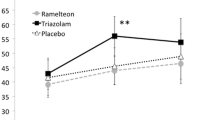Abstract
While outpatients or other users of therapeutic drugs have to be informed about the risk of impaired functioning during driving or work, the prescribing physician needs to be familiar with the side effects of alternative drugs in order to select the most suitable treatment. With this aim, several types of benzodiazepine anxiolytics in low anxiolytic doses (diazepam 5 mg or 10 mg, nitrazepam 5 mg, oxazepam 10 mg, medazepam 10 mg, and alprazolam 0.2 or 0.5 mg - per 2m2 body surface) were tested under laboratory conditions for their effects on vigilance performance. In a double-blind design, 145 healthy volunteers performed a 60 min vigilance test (composed of discriminatory reactions to acoustic stimuli and a secondary visual tracking task) and four short psychomotor tests (lasting 1–7 min each) before and after a single dose of drug or placebo. Subjects described their perception of the drug effect with the help of a mood check list, and fatigue, sleepiness, and effort scales. Only diazepam 5 mg and 10 mg, alprazolam 0.5 mg, and nitrazepam 5 mg caused significant deterioration in vigilance performance along with perceived sleepiness and the need for a greater effort to overcome it. The onset of diazepam effect was quicker, whereas alprazolam effect lasted longer. No effect was noted in the short psychomotor tests except for the Bourdon Cancellation Test, where the first phase of diazepam effect was registered.
Similar content being viewed by others
References
Barbee JG, Black FW, Todorov AA (1992) Differential effects of alprazolam and buspirone upon acquisition, retention and retrieval processes in memory. J Neuropsychiatr Clin Neurosci 4:308–314
Crombez G, Kupers R, Adriaensen H (1991) The effects of a single oral dose of lorazepam and alprazolam on reaction times in young healthy volunteers. Acta Anaesthesiol Belg 42:79–84
Currie D, Lewis RV, McDevitt DV, Nicholson AN (1990) Central effects of angiotensin-converting enzyme inhibitor, Captopril. I. Performance and subjective assessments of mood. Br J Clin Pharmacol 30:527–536
Hart RP, Colenda CC, Hamer RM (1991) Effects of buspirone and alprazolam on the cognitive performance of normal elderly subjects. Am J Psychiatry 148:73–77
Hindmarch I (1988) The psychopharmacological approach: effects of psychotropic drugs on car handling. Int Clin Pychopharmacol 3 [Suppl. 1]:73–79
Horváth M, Frantik E, Novotná E (1978a) Alertness impairing substances and transport and occupational safety: laboratory assessment of hazard. In: Cohen Y (ed) Advances of pharmacology and therapeutics, Vol.9, Toxicology. Pergamon Press, Oxford, New York
Horváth M, Frantík E, Peprník M, Beneš V (1978b) Dissociation of perceived and real effect of ethanol on vigilance performance. Act Nerv Super (Praha) 20:89–91
Horváth M, Frantík E, Kožená L, Krekule P (1985) Chlorpromazine, prothiaden and diazepam effects on vigilance performance compared with reference substances. Act Nerv Super (Praha) 27:31–33
Kerr JS, Hindmarch I, Sherwood N (1992) Correlation between doses of oxazepam and their effects on performance of a standardised test battery. Eur J Clin Pharmacol 42:507–510
Koelega HS (1989) Benzodiazepines and vigilance performance: a review. Psychopharmacology 98:145–156
Kožená L, Frantík E, Horváth M (1987) Search for tension reducing drugs devoid of vigilance impairing effects: laboratory comparison of several anxiolytics. Activ Nerv Super (Praha) 29:189–192
Lasher TA, Fleishaker JC, Steenwyk RC, Antal EJ (1991) Pharmakokinetic and pharmacodynamic evaluation of the combined administration of alprazolam and fluoxetine. Psychopharmacology 104:323–327
Mc Devitt DG, Currie D, Nicholson AN, Wright NA, Zetlain MB (1991) Central effect of the calcium antagonist, nifedipine. Br J Clin Pharmacol 32:541–549
Mirski AF, Rosvold HE (1963) Behavioral and physiological studies in impaired attention. In: Votava Z, Horvath M, Vinař O (eds) Psychopharmacological Methods. Pergamon Press, Oxford
O'Hanlon JF (1988) Are actual driving tests necessary for evaluating drug safety? Int Clin Psychopharmacol 3 [Suppl.1]:81–85
Peck AW, Adams R, Bye C, Wilkinson RT (1976) Residual effects of hypnotic drugs: evidence for individual differences on vigilance. Psychopharmacology 47:213–216
Schmith VD, Piraino B, Smith RB, Kroboth PD (1992) Alprazolam in end-stage renal disease. II. Pharmacodynamics. Clin Pharmacol Ther 51:533–540
Seidel WF, Cohen LW, Dement WC (1985) Effects of alprazolam and diazepam on the daytime sleepiness of non-anxious subjects. Psychopharmacology 87:194–197
Smith OW, Badia P, Rosenberg BG (1969) Are pronouncebility and effort rating psychologically equivalent? Psychol Rep 25:95–99
Sonne J, Loft S, Dossing M, Bolsgaard S, Andreasen F (1991) Single dose pharmacokinetics and pharmacodynmaics of oral oxazepam in very elderly institutionalised subjects. Br J Clin Pharmacol 31:719–722
Tornros J, Laurell H (1990) Acute and carry-over effects of brotizolam compared to nitrazepam and placebo in monotonous simulated driving. Pharmacol Toxicol 67:77–80
Vinař O, Frantík E, Horváth M (1981) Subjectively perceived effects of diazepam, toluene, and their combination. Activ Nerv Super (Praha) 23:179–182
Vojtěchovský M (1970) Vliv spánkové deprivace na farmakodynamické pusobení scopolaminu a benactyzinu človéka (Influence of sleep deprivation on pharmacodynamic effect of scopolamine and benactyzine in man. Research Report, Medicine Faculty, Charles University). Výkumná zpráva LFH UK Praha
Yoshitake H (1971) Relation between the symptoms and feeling of fatigue. In: Hashimoto K, Kogi K, Grandjean E (eds) Methodology in human fatigue assessment. Taylor and Francis, London
Author information
Authors and Affiliations
Rights and permissions
About this article
Cite this article
Kožena, L., Frantik, E. & Horváth, M. Vigilance impairment after a single dose of benzodiazepines. Psychopharmacology 119, 39–45 (1995). https://doi.org/10.1007/BF02246052
Received:
Revised:
Issue Date:
DOI: https://doi.org/10.1007/BF02246052




